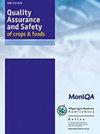Identifying rice grains with premium nutritional quality among on-farm germplasm in the highlands of Northern Thailand
IF 5.3
3区 农林科学
Q1 FOOD SCIENCE & TECHNOLOGY
引用次数: 6
Abstract
Local rice varieties with premium nutritional quality grains are beneficial to consumers, and their genetic traits may be deployed in breeding programmes for many purposes. This study explores grain quality characteristics with health implications of rice germplasm maintained and used by farmers in the highlands of Northern Thailand. Concentrations of iron (Fe), zinc (Zn), phenols and anthocyanin and anti-oxidative capacity were determined in the caryopsis without husk of 77 samples of rice seed collected from farmers. Entries with the highest grain quality characteristics identified were grown together with four standard check varieties at two different elevations in a farmer’s field at Mae Wang District of Chiang Mai province (800 m above mean sea level), as well as in pots at Chiang Mai University (CMU) (330 m above mean sea level). The grain quality characteristics were determined at maturity, separately for 10 individual plants grown at CMU. A wide variation in all the grain quality characteristics was found among samples grown in the farmer’s field. There were approximately twofold differences in the lowest and highest Fe and Zn concentrations, especially high variation in contents of phenols and anthocyanin and anti-oxidative capacity found in grain with purple pericarp. The top entries identified from the farmer’s seed had significantly higher anthocyanin concentration and anti-oxidative capacity than the check varieties when grown together at Mae Wang and CMU, in spite of the strong locality-specific effects on these characteristics. Further variation was found in the grain quality characteristics within each of the selected farmer’s seed samples. Quality improvement could thus be made by either eliminating the poorest performing lines or development of single-seed descent lines from the top-performing plants. The desirable genetic traits can also be used in breeding programme for improvement of grain yield as well as cooking and nutritional quality.在泰国北部高地的农场种质中鉴定营养品质优良的稻米
具有优质营养谷物的当地水稻品种对消费者有利,其遗传特性可用于多种目的的育种计划。本研究探讨了泰国北部高地农民保存和使用的水稻种质的粮食质量特征及其对健康的影响。测定了从农民处采集的77份水稻种子无壳颖果中铁(Fe)、锌(Zn)、酚类和花青素的浓度以及抗氧化能力。在清迈省Mae Wang区(平均海平面以上800米)的一块农田里,以及在清迈大学(CMU)(平均海平以上330米)的花盆里,将鉴定出的具有最高谷物品质特征的参赛品与四个标准对照品种一起在两个不同海拔高度种植。对CMU条件下生长的10株单株在成熟期分别测定了籽粒品质特征。在农民的田地里种植的样品中,所有的谷物质量特征都有很大的差异。在最低和最高的Fe和Zn浓度上存在大约两倍的差异,特别是在紫色果皮的谷物中发现的酚类和花青素含量以及抗氧化能力的高变化。在Mae Wang和CMU共同种植时,从农民种子中鉴定出的顶级品种比对照品种具有更高的花青素浓度和抗氧化能力,尽管这些特性受到强烈的地区特异性影响。在所选农民的每一个种子样本中,都发现了粮食质量特征的进一步变化。因此,可以通过消除表现最差的品系或从表现最好的植物中培育单种子下降系来提高质量。所需的遗传性状也可用于育种计划,以提高粮食产量以及烹饪和营养质量。
本文章由计算机程序翻译,如有差异,请以英文原文为准。
求助全文
约1分钟内获得全文
求助全文
来源期刊

Quality Assurance and Safety of Crops & Foods
FOOD SCIENCE & TECHNOLOGY-
CiteScore
4.60
自引率
7.50%
发文量
61
审稿时长
1 months
期刊介绍:
''Quality Assurance and Safety of Crops & Foods'' is an international peer-reviewed journal publishing research and review papers associated with the quality and safety of food and food sources including cereals, grains, oilseeds, fruits, root crops and animal sources. It targets both primary materials and their conversion to human foods. There is a strong focus on the development and application of new analytical tools and their potential for quality assessment, assurance, control and safety. The scope includes issues of risk assessment, traceability, authenticity, food security and socio-economic impacts. Manuscripts presenting novel data and information that are likely to significantly contribute to scientific knowledge in areas of food quality and safety will be considered.
''Quality Assurance and Safety of Crops & Foods'' provides a forum for all those working in the specialist field of food quality and safety to report on the progress and outcomes of their research.
 求助内容:
求助内容: 应助结果提醒方式:
应助结果提醒方式:


